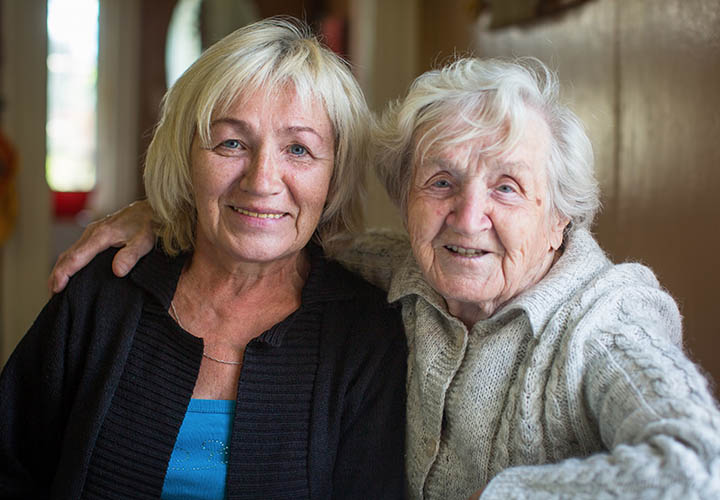
First, Care for Yourself
On an airplane, an oxygen mask descends in front of you. What do you do? As we all know, the first rule is to put on your own oxygen mask before you assist anyone else. Only when we first help ourselves can we effectively help others. Caring for yourself is one of the most important—and one of the most often forgotten—things you can do as a caregiver. When your needs are taken care of, the person you care for will benefit, too.
We hear this often: “ My husband is the person with Alzheimer's, but now I'm the one in the hospital! ” Such a situation is all too common. Researchers know a lot about the effects of caregiving on health and well-being. For example, if you are a caregiving spouse between the ages of 66 and 96 and are experiencing mental or emotional strain, you have a risk of dying that is 63 percent higher than that of people your age who are not caregivers. 1 The combination of loss, prolonged stress, the physical demands of caregiving, and the biological vulnerabilities that come with age place you at risk for significant health problems as well as an earlier death.
Older caregivers are not the only ones who put their health and well-being at risk. If you are a baby boomer who has assumed a caregiver role for your parents while simultaneously juggling work and raising adolescent children, you face an increased risk for depression, chronic illness, and a possible decline in quality of life.

But despite these risks, family caregivers of any age are less likely than non-caregivers to practice preventive healthcare and self-care behavior. Regardless of age, sex, and race and ethnicity, caregivers report problems attending to their own health and well-being while managing caregiving responsibilities. They report:
Family caregivers are also at increased risk for depression and excessive use of alcohol, tobacco, and other drugs. Caregiving can be an emotional roller coaster. On the one hand, caring for your family member demonstrates love and commitment and can be a very rewarding personal experience. On the other hand, exhaustion, worry, inadequate resources, and continuous care demands are enormously stressful. Caregivers are more likely to have a chronic illness than are non-caregivers, namely high cholesterol, high blood pressure, and a tendency to be overweight. Studies show that an estimated 46 percent to 59 percent of caregivers are clinically depressed.
You cannot stop the impact of a chronic or progressive illness or a debilitating injury on someone for whom you care. But there is a great deal that you can do to take responsibility for your personal well-being and to get your own needs met.
Many times, attitudes and beliefs form personal barriers that stand in the way of caring for yourself. Not taking care of yourself may be a lifelong pattern, with taking care of others an easier option. However, as a family caregiver you must ask yourself: “ What good will I be to the person I care for if I become ill? If I die? ” Breaking old patterns and overcoming obstacles is not an easy proposition, but it can be done—regardless of your age or situation. The first task in removing personal barriers to self-care is to identify what is in your way. For example:
Sometimes caregivers have misconceptions that increase their stress and get in the way of good self-care. Here are some of the most commonly expressed:
“ I never do anything right, ” or “ There ʼ s no way I could find the time to exercise ” are examples of negative self-talk , another possible barrier that can cause unnecessary anxiety. Instead, try positive statements: “ I ʼ m good at giving John a bath. ” “ I can exercise for 15 minutes a day. ” Remember, your mind tends to believe what you tell it.
Because we base our behavior on our thoughts and beliefs, attitudes and misconceptions like those noted above can cause caregivers to continually attempt to do what cannot be done, to control what cannot be controlled. The result is feelings of continued failure and frustration and, often, an inclination to ignore your own needs. Ask yourself what might be getting in your way and keeping you from taking care of yourself.
Once you ʼ ve started to identify any personal barriers to good self-care, you can begin to change your behavior, moving forward one small step at a time. Following are some effective tools for self-care that can start you on your way.
 Tool #1: Reducing Personal Stress
Tool #1: Reducing Personal Stress How we perceive and respond to an event is a significant factor in how we adjust and cope with it. The stress you feel is not only the result of your caregiving situation but also the result of your perception of it—whether you see the glass as half-full or half-empty. It is important to remember that you are not alone in your experiences.
Your level of stress is influenced by many factors, including the following:
“ God grant me the serenity to accept the things I cannot change,
Courage to change the things I can,
and (the) wisdom to know the difference. ”
Setting goals or deciding what you would like to accomplish in the next three to six months is an important tool for taking care of yourself. Here are some sample goals you might set:
Example (Goal and Action Steps):
Goal: Feel more healthy.
Possible action steps:
Seeking solutions to difficult situations is, of course, one of the most important tools in caregiving. Once you ʼ ve identified a problem, taking action to solve it can change the situation and also change your attitude to a more positive one, giving you more confidence in your abilities.
Note: All too often, we jump from Step 1 to Step 7 and then feel defeated and stuck. Concentrate on keeping an open mind while listing and experimenting with possible solutions.
Being able to communicate constructively is one of a caregiver ʼ s most important tools. When you communicate in ways that are clear, assertive, and constructive, you will be heard and get the help and support you need. The box below shows basic guidelines for good communication.
When people have asked if they can be of help to you, how often have you replied, “ Thank you, but I'm fine. ” Many caregivers don ʼ t know how to marshal the goodwill of others and are reluctant to ask for help. You may not wish to “ burden ” others or admit that you can't handle everything yourself.
Be prepared with a mental list of ways that others could help you. For example, someone could take the person you care for on a 15-minute walk a couple of times a week. Your neighbor could pick up a few things for you at the grocery store. A relative could fill out some insurance papers. When you break down the jobs into very simple tasks, it is easier for people to help. And they do want to help. It is up to you to tell them how.
Help can come from community resources, family, friends, and professionals. Ask them. Don ʼ t wait until you are overwhelmed and exhausted or your health fails. Reaching out for help when you need it is a sign of personal strength.
In addition to taking on the household chores, shopping, transportation, and personal care, 37 percent of caregivers also administer medications, injections, and medical treatment to the person for whom they care. Some 77 percent of those caregivers report the need to ask for advice about the medications and medical treatments. The person they usually turn to is their physician.
But while caregivers will discuss their loved one ʼ s care with the physician, caregivers seldom talk about their own health, which is equally important. Building a partnership with a physician that addresses the health needs of the care recipient and the caregiver is crucial. The responsibility of this partnership ideally is shared between you, the caregiver, the physician, and other healthcare staff. However, it will often fall to you to be assertive, using good communication skills, to ensure that everyone ʼ s needs are met—including your own.
You may be reluctant to start exercising, even though you ʼ ve heard it ʼ s one of the healthiest things you can do. Perhaps you think that physical exercise might harm you, or that it is only for people who are young and able to do things like jogging. Fortunately, research suggests that you can maintain or at least partly restore endurance, balance, strength, and flexibility through everyday physical activities like walking and gardening. Even household chores can improve your health. The key is to increase your physical activity by exercising and using your own muscle power.
Exercise promotes better sleep, reduces tension and depression, and increases energy and alertness. If finding time for exercise is a problem, incorporate it into your daily activity. Perhaps the care recipient can walk or do stretching exercise with you. If necessary, do frequent short exercises instead of those that require large blocks of time. Find activities you enjoy.
Walking, one of the best and easiest exercises, is a great way to get started. Besides its physical benefits, walking helps to reduce psychological tension. Walking 20 minutes a day, three times a week, is very beneficial. If you can ʼ t get away for that long, try to walk for as long as you can on however many days you can. Work walking into your life. Walk around the mall, to the store, or a nearby park. Walk around the block with a friend.
It is a strength to recognize when your emotions are controlling you (instead of you controlling your emotions). Our emotions are messages to which we need to listen. They exist for a reason. However negative or painful, our feelings are useful tools for understanding what is happening to us. Even feelings such as guilt, anger, and resentment contain important messages. Learn from them, then take appropriate action.
For example, when you cannot enjoy activities you previously enjoyed, and your emotional pain overshadows all pleasure, it is time to seek treatment for depression—especially if you are having thoughts of suicide. Speaking with your physician is the first step. (See the FCA fact sheet.
Caregiving often involves a range of emotions. Some feelings are more comfortable than others. When you find that your emotions are intense, they might mean the following:
 Summing Up
Summing Up Remember, it is not selfish to focus on your own needs and desires when you are a caregiver—it ʼ s an important part of the job. You are responsible for your own self-care. Focus on the following self-care practices:
By Family Caregiver Alliance
| Stay Connected! | |
|
|
|
Related Articles